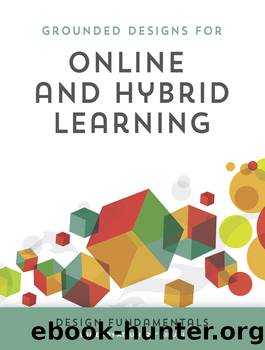Grounded Designs for Online and Hybrid Learning: Design Fundamentals by Hirumi Atsusi;

Author:Hirumi, Atsusi; [HIRUMI, ATSUSI “2C”]
Language: eng
Format: epub
ISBN: 5880798
Publisher: International Society for Technology in Education
Published: 2014-08-15T00:00:00+00:00
Concluding Thoughts
Todayâs students already exist in a digital world, where the use of technology is a seamless, integral part of their daily lives. Smart phones and mobile devices afford access to information and offer collaborative spaces where information is shared, evaluated, and extended anytime, anywhere. As growing numbers of students are avid users of new technologies outside school, it is essential for teachers to learn to use these technologies in their online and hybrid classes. With facilities to share and generate information, Web 2.0 technologies provide the tools to meet the needs of todayâs learners.
When educators use Web 2.0 tools in online and hybrid class settings, students become engaged in learning, improve their technology skills, and perform with increased confidence.
When educators employ Web 2.0 technology tools in their classes, learners shift from simply memorizing information that appears to have little relevance to their lives to acquiring knowledge as they become engaged learners. These technology tools are not a substitute for content; rather, they help us to design learning environments that support students as they construct and collaborate on projects they understand are relevant to them now and will help them in their future careers. All learning environments are defined by teachers, experts in their subject matter. Those of us who use Web 2.0 technologies are convinced that these tools have transformed our students into enthusiastic, engaged learners. Students can use Web 2.0 tools to create, publish, and share a wealth of multimedia resources to demonstrate what theyâve learned as well as contribute to the learning of others (Hendron, 2008).
Meeting the individual learning needs of students with the support of Web 2.0 technologies enables them to develop skills that are supported by but not limited to the instructional environment. Instructional settings including Web 2.0 encourage students to extend their learning beyond the walls of the classroom and the timeframes of the traditional school day. Mobile technologies are already enabling our students to communicate, collaborate, and share information in a variety of settings with diverse communities. By adopting Web 2.0 technologies as tools in our classrooms, we have the satisfaction of fostering our studentsâ learning as an integral part of everyday life, leading them to internalize the positive values of lifelong learning. Navigating the ever-changing world of e-learning through Web 2.0 technologies makes for exciting journeysâfor our students and our own professional growth.
Download
This site does not store any files on its server. We only index and link to content provided by other sites. Please contact the content providers to delete copyright contents if any and email us, we'll remove relevant links or contents immediately.
The Art of Coaching Workbook by Elena Aguilar(50108)
Trainspotting by Irvine Welsh(21023)
Twilight of the Idols With the Antichrist and Ecce Homo by Friedrich Nietzsche(18299)
Fangirl by Rainbow Rowell(8786)
Periodization Training for Sports by Tudor Bompa(7918)
Change Your Questions, Change Your Life by Marilee Adams(7374)
This Is How You Lose Her by Junot Diaz(6438)
Asking the Right Questions: A Guide to Critical Thinking by M. Neil Browne & Stuart M. Keeley(5356)
Grit by Angela Duckworth(5297)
Red Sparrow by Jason Matthews(5195)
Paper Towns by Green John(4797)
Room 212 by Kate Stewart(4736)
Ken Follett - World without end by Ken Follett(4443)
The Sports Rules Book by Human Kinetics(4078)
Housekeeping by Marilynne Robinson(4062)
Double Down (Diary of a Wimpy Kid Book 11) by Jeff Kinney(3925)
Papillon (English) by Henri Charrière(3904)
Exercise Technique Manual for Resistance Training by National Strength & Conditioning Association(3786)
The Motorcycle Diaries by Ernesto Che Guevara(3785)
